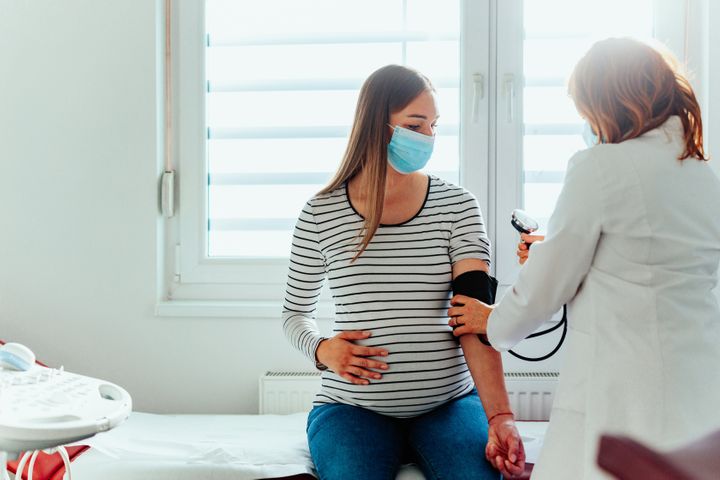Olympic sprinter Tori Bowie died of complications during childbirth at age 32, according to her autopsy, which was released this week. She was eight months pregnant at the time of her death.
Respiratory distress and eclampsia were listed as potential complications, according to The New York Times.
Bowie’s death underscores the severity of the maternal mortality problem in the United States, which has a maternal mortality rate that is double — if not more — than other developed countries like France, Germany, the United Kingdom and Sweden. Her death also underscores the severity of the Black maternal mortality crisis in this country. Black women are three times more likely than white women to die from pregnancy-related causes, according to the Centers for Disease Control and Prevention.
The World Health Organization reports that among the causes of maternal death are severe bleeding after childbirth, infections after childbirth and preeclampsia and eclampsia, or high blood pressure during pregnancy.
And while you may be unfamiliar with eclampsia, you may be aware of preeclampsia — and the two are related. “Eclampsia is a rare but serious complication of preeclampsia,” according to the Cleveland Clinic website.
So, what is eclampsia (and preeclampsia) and what are the signs? Here’s what to know.
What is eclampsia?
Eclampsia is when seizures occur when someone is pregnant or after they give birth. It is usually a severe outcome of preeclampsia, which is a pregnancy complication in which someone has high blood pressure and excess protein in their urine, said Dr. Alison Cowan, an OB-GYN in Colorado and head of medical affairs at Mirvie, a health technology company that is working to develop blood tests to determine one’s pregnancy risks.
Eclampsia can also develop if a pregnant person has HELLP syndrome (which stands for Hemolysis, Elevated Liver enzymes, Low Platelets) or gestational hypertension, said Dr. Ahizechukwu Eke, director of research in the division of maternal fetal medicine at Johns Hopkins University School of Medicine in Baltimore. But preeclampsia is the most common reason why eclampsia develops.
According to the March of Dimes, preeclampsia occurs in 5% to 8% of pregnancies. Eke said severe preeclampsia occurs in .6% to 1.2% of pregnancies in Western countries, and eclampsia occurs in 2% to 3% of people with severe preeclampsia.
While eclampsia overall is not common, it is serious. It’s also considered a new occurrence, meaning the person who suffers from it usually does not have a history of seizures, according to Eke.
Dimensions via Getty Images
What are the warning signs of eclampsia?
There are a number of eclampsia warning signs. The biggest one is high blood pressure. According to Eke, around “75% of [people] who have eclampsia will have a history of high blood pressure.”
About two-thirds of patients with eclampsia would also have a history of severe headaches prior to the seizure, Eke said. Additional symptoms include pain in the upper right abdomen, less frequent urination, dark pee, vision issues like blurred eyesight, swollen hands and feet, and nausea and vomiting, he noted.
While 75% of people who are diagnosed with eclampsia do have symptoms predating the seizures, unfortunately and terrifyingly, 25% do not have any symptoms — “and then all of a sudden, boom, they just have a seizure,” Eke said.
The warning signs of preeclampsia are similar, according to Cowan.
“Symptoms that can commonly occur with preeclampsia are severe headache that doesn’t improve with Tylenol, changes in your vision … you can have pain in the right upper abdomen,” Cowan said. Swelling is another symptom, she said, but it can be confusing since swelling can happen in pregnancy regardless.
Vomiting, high blood pressure and shortness of breath are additional signs of preeclampsia, according to Penn Medicine.
Who is at risk of developing eclampsia?
As mentioned, having preeclampsia is the most common risk factor for developing eclampsia. Additionally, if it’s the person’s first pregnancy, they are at risk, too, Eke said.
Chronic hypertension and chronic kidney disease are risk factors, as well, along with your age. If you’re younger than 16 or older than 35, your chances of developing the condition are greater, he noted. People who are pregnant with multiple children — like twins, triplets or quadruplets — also have a higher risk.
“And then it tends to be more common in minority racial and ethnic groups, most especially Black women,” Eke said.
It’s important for providers to thoroughly check all patients for risk factors and to inform them of the symptoms of preeclampsia and eclampsia, but it’s especially crucial for providers to exhaust all potential risks and complications when it comes to Black patients, since eclampsia is more common in this group, Eke said.
Additionally, if you feel that you are at risk and not getting the care and attention you need, you can find another doctor.
“For everyone regardless of their risk, they need to know the signs and symptoms and they need to be aware of when to call their doctor or midwife for help,” Cowan added.
What can you do to protect yourself?
“The biggest thing about prevention is early recognition of symptoms. So these patients typically will need to call their doctors when they start having [symptoms],” Eke said.
This is especially true for patients with a history of high blood pressure. Eke said many doctors will encourage people to “have a blood pressure cuff at home, and monitor your blood pressure at least once a day.”
You can find at-home blood pressure cuffs at stores like Walgreens, Walmart and on Amazon. “Regular monitoring at home is more accessible than it ever has been before,” Cowan said.
“I never want people to feel [anxious] or afraid of becoming pregnant because of these stories, because the key thing is that, number one, there is a lot we can do to prevent preeclampsia, and number two, if we aren’t able to prevent it entirely, if we recognize it, it’s manageable — we can do everything possible to protect mom and baby as long as we’re able to recognize that it’s there,” Cowan said.
When it comes to the prevention and management of preeclampsia, Cowan said a baby aspirin can be an effective tool in preeclampsia treatment, and so can blood pressure management. Additionally, certain lifestyle behaviors like exercise and eating well can help prevent it, too.
“If you put those all together, it’s actually quite a comprehensive list of things that clinicians can be doing and that pregnant individuals can be doing to decrease their risk of preeclampsia as much as possible,” she said.
As far as what Cowan wants everyone patient to know, she said it’s important to talk to your doctor about your risk and the symptoms.
And, if you are diagnosed with preeclampsia, make sure you know what you need to do and have an emergency plan in place with your doctor, she noted.
“I think knowledge is just that first step to prevention,” Cowan said.


